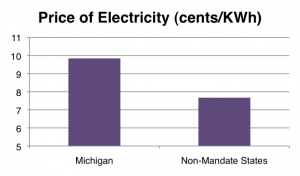![]() Download Michigan’s renewable electricity PDF
Download Michigan’s renewable electricity PDF
 Renewable Mandate Status: On Track
Renewable Mandate Status: On Track
- 2008 Qualified Renewable Generation: 3%[i]
- 2008 Renewable Mandate: 3.5%
- 2020 Renewable Mandate: 22.1%
Eligible Resources: two classes
- Class I (New Resources): 15% by 2020 plus 1% each year thereafter. Eligible Class I resources: photovoltaics, solar, wind, wave/tidal, fuel cells utilizing renewable fuels, landfill gas, certain new hydroelectric facilities or incremental energy from efficiency improvements at existing hydroelectric facilities, low-emission biomass, marine or hydrokinetic energy, and geothermal[ii]
- Class II (Existing Resources): 7.1% in 2009 and thereafter (3.6% renewables and 3.5% waste-to-energy)
Class I compliance schedule:[iii]
[table id=15 /]
Renewable Portfolio History: Original legislation in 1997 created framework for RPS. Massachusetts Dept. of Energy Resources (DOER) adopted RPS regulations in April 2002, requiring all retail electricity providers to reach 1% by 2003 and 4% by 2009. These regulations were expanded in July 2008 (S.B. 2768) to create separate renewable standards (Class I and Class II). S.B. 2768 in June 2008 required the DOER to establish an alternative energy portfolio standard (APS) requiring all retail electricity suppliers to provide a minimum percentage of kWh sales to end-use customers in Massachusetts from alternative generating sources (1% in 2009 increasing to 5% by 2020). S.B. 2768 also set up two state-wide goals: (1) meeting 25% of the state’s 2020 electric load (capacity and energy generation) with demand-side resources and (2) meeting 20% of the state’s 2020 electric load with new renewable and alternative energy generation.[iv]
Credit Trading: Yes
Noncompliance penalty: Retail suppliers can pay an alternative compliance payment of $60.93 per MWh for Class I renewables, $25 per MWh for Class II renewables, $10 per MWh for Class II Waste Energy, and $600 per MWh for the solar carve out.[v]
Electricity Price Ranking: 16th Highest[vi]
- 14.52 cents/KWh in Massachusetts
- 7.67 cents/KWh in non-mandated states
[i] Mass. Ann. RPS Compliance Rep. – 2007 (Nov. 24, 2008), http://www.mass.gov/Eoeea/docs/doer/rps/rps-2007annual-rpt.pdf
[ii] 225 Code of Mass. Reg. 14.05-07 (Jan. 8, 2010), http://www.mass.gov/Eoeea/docs/doer/renewables/solar/225CMR1400Jan8-2010.pdf
[iii] 225 Code of Mass. Reg. 14.07 (Jan. 8, 2010), http://www.mass.gov/Eoeea/docs/doer/renewables/solar/225CMR1400Jan8-2010.pdf
[iv] Database of state Incentives for Renewables and Efficiency, Massachusetts, http://www.dsireusa.org/incentives/incentive.cfm?Incentive_Code=MA05R&re=1&ee=1
[v]Massachusetts Energy and Environmental Affairs, Alternative Compliance Payment Rates, http://www.mass.gov/?pageID=eoeeaterminal&L=5&L0=Home&L1=Energy%2C+Utilities+%26+Clean+Technologies&L2=Renewable+Energy&L3=Renewable+Energy+Portfolio+Standard+%26+Alternative+Energy+Portfolio+Standard+Programs&L4=Compliance+Information+for+Retail+Electric+Suppliers&sid=Eoeea&b=terminalcontent&f=doer_rps_aps_alt_comp_pay_rates&csid=Eoeea.
[vi] EIA, Electric Power Monthly, Table 5.6.B., Average Retail Price of Electricity, June 2010, Released Sept. 15, 2010, http://www.eia.doe.gov/cneaf/electricity/epm/table5_6_b.html



